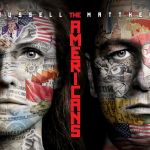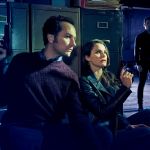
The Americans Anatomy
The inspirations behind one of the best spy thrillers in the TV history
July 17th, 2018
It's 1981. At the White House the former actor Ronald Reagan is now President and the U.S.A. are suspended between economic boom and fear that the cold war with the Soviets can turn into an open and global clash.
Philip and Elizabeth Jennings live in a residential suburb of Washington, have been married for 15 years, have two teenage kids, a travel agency and the mask of the perfect American family well-hung on their faces and their lives.

Because Philip and Elizabeth are actually Mikhail and Nadezhda, secret agents serving the KGB, members of the "S directorate". Born, raised and trained in the Soviet Union for the purpose of infiltrating in the United States.
The result is a double existence that triggers the fragmentation of a personal identity that fractures and recomposes all the time, including lies, alter egos, secret missions, crimes and suspense, a labyrinth of uncertainties, lacerating moral problems, ideals to fight for, a myriad disguises and wigs, a perfect soundtrack and an 80s painting never over the top.
These are some of the ingredients of The Americans, a FX TV series starring Matthew Rhys and Keri Russell, which arrives this year in its final season, the sixth.

Someone wrote that the show is "one of the most dense, refined and narratively powerful products on the television scene" and we confirm this by warmly suggesting the vision.
With The Americans the Cold War has never been cooler.
Feel like: Robert Frank
The Americans is not only the title of a beautiful TV series set during the Cold War period, it is also the title of a seminal work in the history of photography, the work of Robert Frank.
In 1955 the artist, defined by the New York Times as "the most influential photographer in life", encouraged by his teacher Walker Evans, applied for a scholarship of the Guggenheim Foundation: he obtained it and used the money to realize a project that changed the way of conceiving reports.
Frank travels for a year in a Ford Business Coupe, photographing the streets, faces, squares, bars and shops of 48 states in the United States.
Among the more than 27 thousand photographs taken, he chooses 83 in black and white and collects them in the book The Americans published in the United States in 1959, with a preface by the writer Jack Kerouac.
Frank immortalizes a territory and its inhabitants "that many Americans could not or did not want to see: a sad, difficult, divided, more melancholic than heroic country". On the New York Time Magazine, Nicholas Dawidoff writes that the creative work shows "what it means to be poor or rich, in love or alone, young or old, white or black, working too much or sleeping in a park, doing politics or praying".
His blurry portraits, wavy shots and seemingly random cuts are, according to Elliott Erwitt of the Magnum agency, the beginning of a new kind of "apparently sloppy, but only apparently, and very emotional" photography.
"It was a shocking work because it showed things like they were," reporter Sean O'Hagan explains in the Guardian.
Dress like: Balenciaga by Demna Gvasalia


When talking about the '80s, most people imagine fluffy hair, neon colors, Frankenstein style shoulder pads and strong make up, a sort of exaggerated stereotype, a hybrid between some character of a John Hughes movie and the cover of a Culture Club album.
The Americans, however, is not set in Greenwich Village at the height of the punk scene, but in the suburban Virginia in 1981 and has as its protagonist a pair of Russian spies camouflaged in the United States as travel agents. Which, translated in aesthetic terms, means no excess or details that attract too much attention.
To try to create a series of authentic looks, Jenny Gering (28 episodes, 2013-2016) and Katie Irish (36 episodes, 2016-2018), who have alternated as a costume designer in the 6 seasons of the show, have consulted every possible source.
The vintage materials of eBay, Etsy and the stores in New York were fundamental in composing the various outfits; films like Ordinary People, Fast Times at Ridgemont High or Eyes of Laura Mars; old editions of Vogue, Playboy and Life; the Sears catalog; the advertisements of the time; the high school yearbooks; old family photos and even pictures of the White House led by Reagan.
Thus, in the series the male characters (mostly FBI members, diplomats and businessmen) wear suits and ties, often three-piece suits with wide silhouettes.
Elizabeth Jennings' wardrobe is much more eclectic.
"It's a completely opposite silhouette compared to what people consider to be '80s. I wanted the late '70s, strong woman in the early 80s, classic cut, beautiful fabrics, a look like Faye Dunaway, Charlotte Rampling - a kind of sexy without trying too hard "- explains Gering and continues -" ... the opportunity to really show the female figures and the sartorial beauty. Everything is very tactile - there is a lot of leather and suede and the palette is lovely, there is very little black and gray, it is very autumnal, very earthy, very rich ..."
The character played by Keri Russell wears mom jeans, silk shirts, turtlenecks, knee-high boots, men's overcoats, gold chains, some vintage Gucci pieces, Yves Saint Laurent, Valentino and Harve Benard.
The looks that really capture the attention and are commented by the fans season after season are those used as disguises.
For The Americans, the costumes department created over 120 pieces for the different aliases of Philip and Elizabeth, giving birth to Patty, the beauty seller Mary Kay; Brenda, the fashion buyer with a hairstyle inspired by the model Linda Evangelista; the blond Clark Westerfield, an internal affairs investigator who ends up marrying his informant Martha; Stephanie, the home nurse with the permanent, the big eyeglasses, the fleece sweaters and the sweatpants; the Texan cowboy...
Looking at all these disguises, one question pops in our minds: was the Cold War the hottest moment for wig business?
Think like: Deep Undercover: My Secret Life and Tangled Allegiances as a KGB Spy in America by Jack Barsky

Albrecht Dittrich was born in 1949 in eastern Germany. At university he joins the communist party and here he makes his first encounter with the dark side of communism, when a mysterious man hired by the Stasi, the secret police of East Germany, knocks on the door of his dorm and recruits him for a KGB training program. The purpose? A future undercover in New York.
In the period of training as a spy, the man takes English lessons, erased his accent, studies every detail of American culture, but also cryptography, methods of surveillance and all the other "tricks" that Jennings use in the TV series.
When Dittrich arrives in the Big Apple, in October 1978, he is 29 and has a new identity: Jack Barsky. After a degree in computer systems at Baruch College, he finds a job in the information technology department of the Metropolitan Life Insurance Co. His "fake" career, as well as the one in the KGB, takes off, until the moment when the most dangerous thing happens: Barsky falls in love with America.
He writes: "The chinks in my ideological armor began to grow into wide open cracks”.
If you want to know how the story goes on, you must read the book.
Sound like: Peter Gabriel We Do What We Told

For six consecutive seasons, music supervisors P.J. Bloom and Amanda Krieg Thomas used the songs as a primary tool in the economics of storytelling and staging, succeeding in recalling a precise era.
This incredible time capsule has played Fleetwood Mac, Queen, U2, Phil Collins, Roxy Music, Cure, Roberta Flack, Yazoo, Devo, Rolling Stones, Bauhaus and many others, but no artist has channeled the complex emotional tone of The Americans like Peter Gabriel. His songs Games Without Frontiers, Here Comes the Flood and Lay Your Hands on Me appeared in several episodes of the show, but We Do What We Told, heard in the premiere of the last season, outlines perfectly the mood of Elizabeth Jennings.
The woman has just received instructions from a rogue wing of the KGB to counter the arms reduction negotiations between the Reagan government and the reforms of Mikhail Gorbachev and the song follows her journey home.
In the bathroom of the plane, with a poison pill around her neck to be swallowed in case of capture, Elizabeth is tormented. She is not sure she wants to do what Russia asks her, but she has been trained to obey for the good of her country.
In the background Gabriel's voice repeats: "One doubt, one voice, one war, one truth, one dream" ("A doubt, a single voice, a war, a truth, a dream") and "We do what we're told" ("Let's do what we are told"), underlining the most successful sequence from the point of view of musical diegesis.
This particular choice is even more significant when one considers that the song was inspired by experiments conducted by Yale psychologist Stanley Milgram to explore "the conflict between obedience to authority and personal conscience." In the 1960s the scholar asked 40 men of different social background and between the ages of 20 and 50 to teach the word pairings to "students" and then to question them on what they had learned. "The teachers" had at their disposal a panel with which they could inflict on the student as a punishment for every error, an electric shock.
Fortunately, the shocks were not real, but they seemed to, and a large percentage of people in the study continued to cause pain because an authoritative figure told them they had to do.
Taste like: Caviar vs McDonald
![]() Love like: The chemistry between Matthew Rhys and Keri Russell
Love like: The chemistry between Matthew Rhys and Keri Russell


The Americans is one of the most beautiful and underrated series of the last years.
It is very well written, it has a perfect soundtrack, an efficient costume department, a refined way of describing human relationships, particularly the internal dynamics of a wedding. But it would not have been so interesting without Matthew Rhys and Keri Russell. The chemistry between the two actors is touchable (they actually ended up together also in real life), as well as their talent.

Without Rhys, already famous thanks to Brothers & Sisters, Philip would not have had the same humanity, the same facets that make his character more than a spy.
And what about Russell? The Felicity of the popular 90s TV series produced by J.J. Abrams has become a beautiful, talented and fashionable woman (look at her red carpet looks). Her microexpressions and her silences give body to a woman often rough and anaffective, torn between obedience to an ideal instilled in her since childhood and the reality in which that same illusion is shattering in front of her eyes.



























































